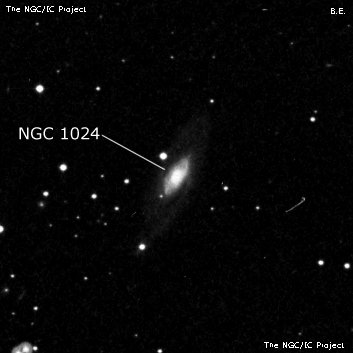
William Herschel discovered NGC 1024 = H II-592 = h243 on 18 Sep 1786 (sweep 591) and logged "pB, S, E, bM". John Herschel logged on 19 Jan 1828 (sweep 121): "F; R; bM; 20"; has a * 11m 40? nf; 25" distant."
400/500mm - 17.5" (12/23/92): fairly faint, fairly small, elongated 2:1 NNW-SSE, rounder bright core, brighter along major axis. A mag 11 star is 42" NNE of center. Located 13' NNE of mag 6.8 SAO 93034. Forms a pair with NGC 1029 7' ESE.
600/800mm - 24" (1/12/13): bright, moderately large, very elongated 3:1 NNW-SSE. Sharply concentrated with a very bright, elongated core ~25"x15" and much fainter extensions increasing the size to ~1.2'x0.4'. Interestingly, the elongation of the core seems is slightly misaligned with respect to the major axis of the extensions. The extremely low surface brightness outer arms were not seen. A mag 12 star is 0.7' NNE of center. Brightest in a trio (KTG 9) with NGC 1029 7' SE and NGC 1028 6' E, though the latter lies in the background.
900/1200mm - 48" (10/30/16): very bright, large, elongated 3:1 NNW-SSE. Sharply concentrated with a large, very bright elongated core, and a more circular nucleus. A very large, much lower surface brightness halo, extends nearly 3'x1'. The halo is a bit more diffuse on the northwest side. The minor axis nearly reaches a mag 12.3 star 0.7' NNE of center. A mag 13.7 star is off the SSE end, 2.2' from center. Brightest in a group with nearby NGC 1028 and 1029.
Notes by Steve Gottlieb